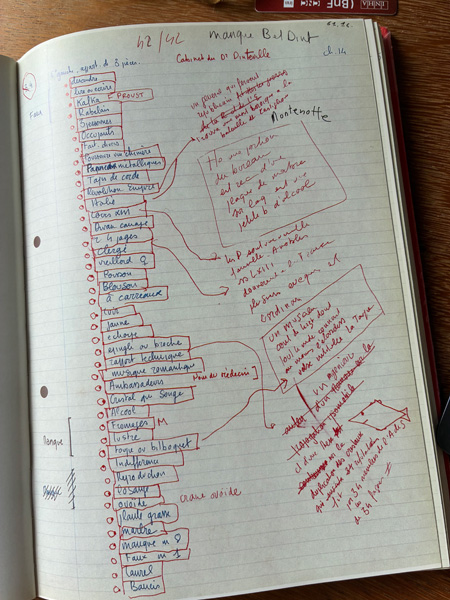 Image courtesy of Fiona McMurrey, from the Cahiers de La Vie comme mode d’emploi, by Georges Perec, from the archives of the BnF Mitterrand
Image courtesy of Fiona McMurrey, from the Cahiers de La Vie comme mode d’emploi, by Georges Perec, from the archives of the BnF Mitterrand
In an age of glowing screens and instant replies, the French still have a love affair with paper. Step into any stationery shop in Paris or Lyon and you’ll feel it immediately: the scent of ink, the rows of notebooks bound in linen, the deliberate weight of pens designed to glide. Writing — not typing — remains part of the French rhythm of life.
While much of the world has surrendered to the convenience of digital notes and emoji conversations, the French have kept alive something older and more tactile: the art of handwriting.
It’s not nostalgia — it’s philosophy.
The Cultural Romance of Ink and Paper
From school desks to cafés, writing by hand has long been a French ritual. French students learn cursive — écriture manuscrite — from an early age, and it’s taken seriously. Neat penmanship isn’t just about presentation; it’s a reflection of discipline and beauty. A well-formed line of ink is considered a mark of respect — for words, for ideas, and for the person who will read them.
This reverence goes back centuries. France’s literary icons — from Proust’s looping scrawl to Colette’s careful edits — composed entire novels by hand. Even today, many contemporary French writers begin with notebooks before turning to screens. The motion of pen to page, they say, connects thought to feeling.
The French Notebook Obsession
In France, notebooks aren’t mere school supplies — they’re cultural objects. The most famous is Rhodia, a brand founded in Lyon in the 1930s, with its signature orange cover and perfectly smooth pages. Every French student knows the crisp squares of Clairefontaine paper, designed for perfect alignment and clarity.
For adults, notebooks take on new lives: travel journals, recipe books, reading lists, sketches, and letters never sent. Writing by hand transforms the everyday into a ritual.
There’s even a quiet status to the tools: a fountain pen by Waterman or J. Herbin ink in “Bleu Myosotis.” The French instinctively understand what many cultures have forgotten — that beauty in daily tools makes ordinary life poetic.
Letters as an Act of Intimacy
To send a handwritten letter in France is still a gesture of love, of friendship, or of gratitude. It’s deeply personal, almost cinematic — like a scene from a film streaming on France Channel, where a character pauses before sealing an envelope, lost in thought.
Unlike an email, a letter takes time — to write, to send, to wait for. The delay becomes part of the beauty. You can’t scroll past a letter; you unfold it. You hear the sound of the paper, you see the writer’s hand.
Many French still keep old letters tied with ribbon or tucked into drawers, not for sentimentality, but because each one carries the texture of real emotion. It’s a tangible archive of connection.
Writing as a Form of Resistance
In a fast-paced, digital world, handwriting has become a quiet act of rebellion. When the French choose paper, they are also choosing presence — a slower, more deliberate rhythm.
It’s the same spirit found in other aspects of French life: the two-hour lunch, the long Sunday stroll, the insistence that some things should not be rushed.
To write by hand is to say: this moment matters enough to be held.
Philosopher Roland Barthes once described writing as “an erotic act of the hand.” The French have never forgotten that — and perhaps that’s why the pen still feels sensual in France.
How to Reclaim the French Way of Writing
You don’t have to live in Paris to bring a touch of this paper romance into your life.
Try these rituals:
1. Keep a small notebook with you.
Write down thoughts, observations, or the names of films and songs you love. The act of writing transforms fleeting ideas into tangible memories.
2. Send one handwritten letter this month.
To a friend, a mentor, or even yourself. Choose beautiful stationery and take your time.
3. Write your plans by hand.
French productivity often comes from structure — not apps, but ruled pages and a fountain pen.
4. Collect beautiful paper.
Visit a local stationery shop and choose a notebook you’ll actually want to open. It’s not indulgence; it’s inspiration.
5. Copy your favorite line from a French film.
Turn it into a daily affirmation. As any film lover knows — especially those who stream on France Channel — the best lines are meant to be written down, not forgotten.
Why It Endures
The French habit of handwriting endures because it reflects something timeless in the culture: a devotion to form, thought, and feeling.
Writing on paper slows life to a human pace — it asks for focus and offers reward.
In a society that constantly scrolls, the French keep writing — and by doing so, they remind us that the best stories begin not on a screen, but in ink.